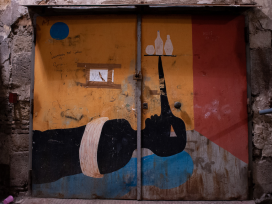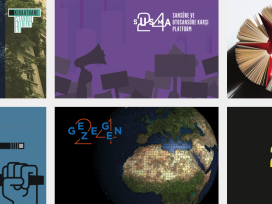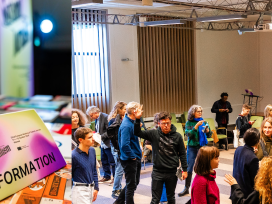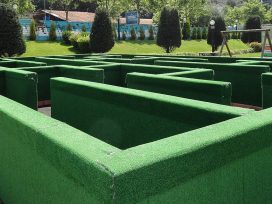The market mentality in the cultural sphere creates such an economy of power and speed that magazines might be thought to be the most negligible elements of what’s going on. It is not the cosmos that matters, it is the stars: cash desks, platforms, best-seller lists, ceremonies, mega-events, billboards, advertisements – the media glitz that also casts its light on culture and envelopes everything in its protective aura. This is naturally a mechanism that can bypass the varied universes of magazines to sell values without having to create them first. It is the force that puts excessive agendas on the market with its rashness and its tumultuous style. Consequently, it is getting more and more difficult to hear the rhythm of the world of magazines, which are meanwhile themselves having trouble making out the sound of their own voices.
Nevertheless, various mentalities in a cultural environment can still be found, with all their intensities and diversities, especially in magazines. If you are interested in familiarizing yourself with the currents, gathering places, and different viewpoints within a given culture, one of the best ways to establish contact with that culture and track its development is through magazines. Of course, following the work of academics and keeping an eye on book publishing tells you a great deal, too. But compared with the world of magazines, they lack something. They are much more likely to be misleading. In Turkey, if you want to keep prejudices at arm’s length, to hold a flexible but useful tool in your hands that will provide you with an awareness of what is really going on, if you want to know which reactions are shown to what by whom, and what agendas and discussions people are actually dealing with, then you have to keep an eye on the cultural magazines. Check them out, from the most central to the most peripheral, and you will be travelling in the map of mentalities…
Magazines are the forces that come closest to creating an independent stance and an uncontrolled zone. They have a tendency to give birth to desires, to perpetuate desires, and to make desires collide. They bring grassroots potential out onto the streets where they can be realized – or discussed first. They can inhabit in-between positions. You can find knowledge in magazines that has not been filtered by mediators or cultural representatives. What is true for Turkey is naturally true for other places; if you can imagine the map of all the magazines in any country then you can imagine the map of mentalities there. There are always magazines that only mirror, that merely record the cultural environment as it is; they show only what they see and thus affirm what is being staged. They are those that canonize, and we can thus call them “canonizing” magazines. At the other extreme, we have “talking” magazines, those that open up new channels for people without other means of expression. Many novel ideas you wouldn’t encounter on other public platforms find a voice in magazines; some are even formed by them. Both “canonizing” and “talking” magazines are crucial for the map of mentalities – “canonizing” magazines show the limits and norms, “talking” magazines show the movement, the liveliness, the transgression.
Turkish contemporary art and art-ist magazine
We can take the Turkish contemporary art scene as an example. Turkish contemporary art has a relatively short history. In the late 1990s, contemporary art acted as a kind of stimulant for the dominant painting scene. The first issues of the magazine art-ist already show this dynamic: new contemporary art in Turkey was taboo-breaking, avant-gardist, radical, anti-nationalist, universalist, and young. The artists putting on solo shows were the same ones running art-ist. There were already strong art magazines in Turkey when art-ist first appeared. Most were opposed to contemporary art. They were much stronger financially, had more human and material resources to draw on, had higher production standards, and so on. They were the ones who were against the “West,” who were nationalist in one way or another, who rejected contemporary art categorically and who hated seeing young Turkish artists flirting with Western art without their consent. Canonizing art magazines had an institutional character in Turkey; they were, and still are, published by banks, big newspaper corporations, or powerful galleries.
From its beginning, art-ist has always been crucial for the Turkish contemporary art scene. It started out as an “avant-garde” publication, in touch with the latest art happenings, performance art events, and so on. And it understood contemporary art as a struggle. After 2005, art-ist decided that avant-gardism was not needed anymore. Interest in contemporary art is growing in Turkey – but not in the way imagined, where critical approaches become the dominant perspective. After 2005, art-ist decided to publish in Turkish only – to focus entirely on the Turkish scene and to intervene more at that level.
As an interesting aside, there is another magazine in Turkey that is also called Artist but without the hyphen between “art” and “ist.” It can be classified as a “canonizing” magazine, one tailored to fit popular taste, as witnessed when it cut its cover price to I YTL (less than euro 1,00). After some months, it split into two magazines: Artist Modern and Artist Contemporary. Two magazines with names that are so similar and approaches that are so different.
This shows how the currents are changing: in 1999, people tried either to ignore or denounce art-ist and contemporary art; in 2007, they are imitating it.
In the contemporary art field, Istanbulism rules – big companies are starting to spend more money on contemporary art instead of putting money into traditional, locally based galleries and are shaping a situation in which they are sheltered under the umbrella of a brand they all invest in: Istanbul. It is a commonly held idea that contemporary art would do great things for this brand.
Major canonizing art magazines celebrate Istanbulism while independent magazines like art-ist try to knock it off track via critical discourse.
The leftist tradition of academic research outside the academy
There is a tradition of leftwing critical culture journals in Turkey that see themselves as being non-academic. They have opened the door for high-quality theoretical debate without the necessity of an academic base.
High-impact cultural magazines located outside academic institutions somehow “civilize” academic debate and create connections between the intelligentsia and the broader public. These magazines are distinct from closed-circuit academic journals and they have the power to directly affect the political and cultural situation. They do not have high circulations but they do reach many different people from different kinds of backgrounds and positions. They come from a leftist tradition of intellectual production outside the universities, which have been completely in the grip of rightwing regimes – especially after the coup d’état of 1980. Today, universities are thought to be freer, at least on paper, and we are witnessing a greater number of critical works written by academics. But magazines nonetheless open up completely different channels. Take the issue of nationalism, for example. Many strong theoretical works analyzing Turkish nationalism and many important field studies have been done by leftist independent researchers and were first published in leftwing cultural magazines.
Knowing that they will be circulated among professional academicians only and will not reach the general public, one could expect academic journals to create more tools for resistance while talking in “hidden transcript.” But instead, they take advantage of their shelter from public visibility while remaining under the control of the academic authorities. Independent theoretical magazines, on the other hand, come from a leftist background and usually aim to intervene in the “public transcript” – they are much more inclined to perform parrhesiatic acts.
Poetry magazines – outsiders
Poetry magazines in Turkey should be mentioned if we are talking about the culture market and forms of resistance to it. There are a great many poetry magazines in Turkey, which are not only published in big cities but also in smaller towns.
Visual poetry is also becoming popular among young Turkish poets. This is the result of today’s avant-garde attitude. And there are also ironic groups calling themselves “surrealists” that make wall paintings and xerox zines. All of this is closely related to visual culture. After 2000, there was a greater accumulation of capital in the field of literature as well as in art. More and more novels are being published every year. Only 20-30 new titles are published annually in the 1990s; now, hundreds of new Turkish novels come onto the market every year. With 100 of these first novels, an enormous numbers of new writers are emerging in Turkey. This is mostly because some novels have brought money and fame to their authors. There is more media coverage and interest in novels. Newspapers and companies are getting in on the deal. This is making things difficult for literary magazines, who no longer find it easy to compile their own programmes.
Poems do not sell anyway, so promotion simply does not make sense. The work of poets is therefore not marketed and they have no share in the new capital flows. That frees poetry in some sense. There is a very vivid poetry scene with many poetry magazines and although the poets tend to be bit self-referential, they are still full of ideas and have sparked off many debates. For the powers-that-be, poetry is ignorable. This creates a void and a potential for poets. As visual poetry and experimental poetry become popular, new manifestos are being declared one after another.
But here we see the difference between critical contemporary art magazines and critical poetry magazines: it is easier to continue an alternative approach in poetry for there is no seduction coming from “capital”. Poetry is market-free and at the same time has no value for Istanbulist tendencies. In the contemporary art field, however, critical approaches have to deal with the market trends and Istanbulist projects. Thus, contemporary art discussions create a political conflict zone.
Alternative publishing in Istanbul
Finally, I would like to go into some detail about our own alternative publishing adventures in Istanbul. Different forms of publication can be used by one and the same group to
communicate more or less similar ideas. When we talk about “talking” magazines and
“alternative publishing”, there is one other very important thing to consider: form. That is what determines the end result.
For the last eight years, we have been working on a research and publication project in Istanbul from a post-structuralist anarchist perspective. This is an anarchism that goes beyond the limits of politics to include post-Eurocentric, non-modernist elements, contemporary theoretical developments, and culture in a broad sense. We have a conception of anarchy that annexes diverse fields as well as areas of everyday life. The project has gone through three main phases.
Phase one: The Karasin Anarchist Collective
Between 1996-1998, we called ourselves the Karasin Anarchist Collective (in some places we used the name Karasin Working Group). We published a xerox-zine, a monthly photocopied newspaper, pamphlets, and ran a website. We put out two issues of the magazine, three issues of the newspaper, and eleven pamphlets. The collective was composed of a small core of members who took on the tasks of translating, writing, reading and discussing.
At first we used a second-hand photocopy machine, but that was neither efficient nor as cheap as we imagined. So we bought an all-in-one printer that became the mother of Karasin publications.
Karasin made sure it remained an independent medium, stayed “outside”. We wrote, translated, published, and distributed ourselves. In parallel to photocopy publishing, we set up a website; these simply structured web pages achieved a great deal. They enabled our texts to reach many places and to stay alive for a long time. And Internet publication was much, much easier.
With photocopy publishing we had serious distribution problems. We found shelf space in rock-and punk-oriented music shops, yet more and more bookshops started to demand invoices or stopped selling unregistered magazines. We were having real difficulty distributing our material in other cities. Besides Istanbul, we were distributing only small amounts in Ankara and Bursa. We were receiving much more feedback through our website. We found out that people even made pamphlets themselves after downloading the material.
Photocopy was limiting our dialogue with people outside the anarchist and subculture circles. We wanted to spread our ideas to a larger readership, to different people with different interests. Since our aim was to affect all aspects of life and to strengthen heterodoxies, we wanted to enter various fields. We therefore began to seek ways to disseminate our material beyond anarchist and punk communities.
The second period: Détournement, or working inside other publications and media
Between 2000 and 2002, we worked inside various media platforms, sometimes trying to transform them, sometimes trying to change their direction a bit, and sometimes just trying to live and function inside them. In this two-year period, we developed a radical post-structuralist anarchist approach through the articles we wrote for Varlik, Turkey’s oldest literary magazine. Beginning with a special dossier on hypertext, we started to prepare a series of dossiers on theoretical concepts such as hypertext, post-feminism, potlatch economies, meta-geography, everyday life, rhizomatic thinking, and cyberfeminism. Besides Varlik, we wrote for the monthly Okuz, which is popular because it is a comic magazine as well. While we were writing for Okuz, we tried to find forms to embrace everyday life and current political issues for non-professional readers, using dialogues, photographs, jokes, and so on.
During this period we also worked for Acik Radyo (a radio station) and Studyo Imge (a publisher). The advantage of operating on so many different platforms included the chance to reach a much wider audience, to developing our ideas, to meet new people, and to attract contributions from different angles. But this period also had its disadvantages. This style of “working everywhere” made it difficult to understand our position, since not everyone follows every type of media with the same degree of attention. Other contributors to the media we shared, and the political and cultural differences in their stances, influenced the way our project was conceived by the public. Our neighbours were affecting us somehow. And although this opened up many positive new areas, it was also limiting our expression. We were again in need of a new medium where we could initiate our own context and at the same time retain our relations with a wider audience.
The third stage: A legal magazine of our own – Siyahi
In 2003 we started thinking about an alternative approach: a “talking” magazine of our own. But we did not want to produce a photocopy magazine this time; we wanted printed material. With a xerox magazine, you have a feeling of independence, you stay clean, but you make everything much more complicated for your readers. It is the fantasy of being outside the machine. A website is always the best, most accessible solution. And you are everywhere at the same time when you are online. But you cannot smell what you do, nor touch it. This may be considered a problem when dealing with emotional issues and ideas. Since we began publishing Siyahi, we have always enjoyed the exciting smell of a new issue.
We started to publish Siyahi in November 2004 and have published nine issues thus far. Although Siyahi is positioned within the global anarchist scene, it is also conceived as a critical and political cultural magazine. The journal is dedicated to analyzing the history and theory of anarchism, along with current developments in political theory and philosophy, and the social and cultural agenda of radical politics in Turkey. We are interested in anarchism as an unorthodox mode for culture in general – to put it simply, in supporting non-representational, anti-hierarchical, non-pyramidal, horizontal elements of life. For this purpose, we rethink anarchism in the light of poststructuralist thought. We dedicate each issue to a specific subject: “Libertarian education” was the title of a recent dossier; another looked at relations between anarchism and Nietzsche. Special issues have included queer theory, experimental poetry, leftist identity, the EU and Turkey, and the politics of contemporary art. Siyahi marks the period we are in now, and we are planning to continue publishing it. Of course, only for as long as we still have “something to say”.






